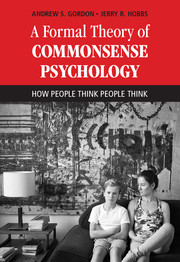Book contents
- Frontmatter
- Contents
- Part I Commonsense Psychology
- Part II Background Theories
- Introduction
- 5 Eventualities and Their Structure
- 6 Traditional Set Theory
- 7 Substitution, Typical Elements, and Instances
- 8 Logic Reified
- 9 Functions and Sequences
- 10 Composite Entities
- 11 Defeasibility
- 12 Scales
- 13 Arithmetic
- 14 Change of State
- 15 Causality
- 16 Time
- 17 Event Structure
- 18 Space
- 19 Persons
- 20 Modality
- Part III Commonsense Psychology Theories
- Appendix A First-Order Logic
- References
- Index
18 - Space
from Part II - Background Theories
Published online by Cambridge University Press: 01 September 2017
- Frontmatter
- Contents
- Part I Commonsense Psychology
- Part II Background Theories
- Introduction
- 5 Eventualities and Their Structure
- 6 Traditional Set Theory
- 7 Substitution, Typical Elements, and Instances
- 8 Logic Reified
- 9 Functions and Sequences
- 10 Composite Entities
- 11 Defeasibility
- 12 Scales
- 13 Arithmetic
- 14 Change of State
- 15 Causality
- 16 Time
- 17 Event Structure
- 18 Space
- 19 Persons
- 20 Modality
- Part III Commonsense Psychology Theories
- Appendix A First-Order Logic
- References
- Index
Summary
SPACE AND SPATIAL ANALOGIES
Many “top-level” ontologies begin with a distinction between physical objects and abstract entities. By contrast, we have made it through thirteen background theories without ever mentioning the distinction. The reason for this is that the core of language doesn't seem to care much about this distinction. We can be in a building, and we can be in politics and in trouble. We can move a chair from the desk to the door, and we can move the debate from politics to religion and move money from one bank account to another. Ontologies that begin with this distinction, or similar ones likeCyc's tangible–intangible distinction (Lenat and Guha,1990), fail to capture important generalizations in language and as a result very nearly make themselves irrelevant in linguistic applications at the outset.
It has frequently been observed that we understand many abstract domains by analogy with spatial relations (e.g., Vico, 1744; Richards, 1937). A relatively recent rediscovery of this old truth was by Lakoff and Johnson (2008). We operate in space from the moment we are born and thus build up very rich spatial models. By setting up a mapping between a new domain and space, we are able to commandeer these rich models for the new domain and think about it in more complex ways.
This would seem to indicate that the very first theory one should develop in an enterprise such as ours is a very rich theory of space, and then set up somemechanism for analogical reasoning. But what does analogical reasoning involve? It is amatter of identifying common properties of the things being compared, reasoning about them in the familiar domain, and then transferring the results to the new domain. But what is typically transferred from space to new domains in spatial analogies is not just any property. Very rarely, for example, do we transfer the properties of hardness or color or precise distance. The common properties that are transferred are usually topological properties.
In these background theories we have identified some of the most important underlying properties of the spatial domain that are most frequently utilized in analogies – such things as complex structure, scalar concepts, change of state, and so on.
- Type
- Chapter
- Information
- A Formal Theory of Commonsense PsychologyHow People Think People Think, pp. 202 - 206Publisher: Cambridge University PressPrint publication year: 2017



